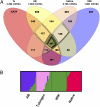Extensive genetic diversity and substructuring among zebrafish strains revealed through copy number variant analysis
- PMID: 22203992
- PMCID: PMC3258620
- DOI: 10.1073/pnas.1112163109
Extensive genetic diversity and substructuring among zebrafish strains revealed through copy number variant analysis
Abstract
Copy number variants (CNVs) represent a substantial source of genomic variation in vertebrates and have been associated with numerous human diseases. Despite this, the extent of CNVs in the zebrafish, an important model for human disease, remains unknown. Using 80 zebrafish genomes, representing three commonly used laboratory strains and one native population, we constructed a genome-wide, high-resolution CNV map for the zebrafish comprising 6,080 CNV elements and encompassing 14.6% of the zebrafish reference genome. This amount of copy number variation is four times that previously observed in other vertebrates, including humans. Moreover, 69% of the CNV elements exhibited strain specificity, with the highest number observed for Tubingen. This variation likely arose, in part, from Tubingen's large founding size and composite population origin. Additional population genetic studies also provided important insight into the origins and substructure of these commonly used laboratory strains. This extensive variation among and within zebrafish strains may have functional effects that impact phenotype and, if not properly addressed, such extensive levels of germ-line variation and population substructure in this commonly used model organism can potentially confound studies intended for translation to human diseases.
Conflict of interest statement
The authors declare no conflict of interest.
Figures





Similar articles
-
Tissue-Specific eQTL in Zebrafish.Methods Mol Biol. 2020;2082:239-249. doi: 10.1007/978-1-0716-0026-9_17. Methods Mol Biol. 2020. PMID: 31849020
-
An Interrogation of Shared and Unique Copy Number Variants Across Genetically Distinct Zebrafish Strains.Zebrafish. 2019 Feb;16(1):29-36. doi: 10.1089/zeb.2018.1644. Epub 2018 Nov 10. Zebrafish. 2019. PMID: 30418105 Free PMC article.
-
Inter- and intra-breed genome-wide copy number diversity in a large cohort of European equine breeds.BMC Genomics. 2019 Oct 22;20(1):759. doi: 10.1186/s12864-019-6141-z. BMC Genomics. 2019. PMID: 31640551 Free PMC article.
-
Current analysis platforms and methods for detecting copy number variation.Physiol Genomics. 2013 Jan 7;45(1):1-16. doi: 10.1152/physiolgenomics.00082.2012. Epub 2012 Nov 6. Physiol Genomics. 2013. PMID: 23132758 Free PMC article. Review.
-
Copy number variants (CNVs) in primate species using array-based comparative genomic hybridization.Methods. 2009 Sep;49(1):18-25. doi: 10.1016/j.ymeth.2009.06.001. Epub 2009 Jun 21. Methods. 2009. PMID: 19545629 Free PMC article. Review.
Cited by
-
Pattern of fin rays along the antero-posterior axis based on their connection to distal radials.Zoological Lett. 2019 Sep 18;5:30. doi: 10.1186/s40851-019-0145-z. eCollection 2019. Zoological Lett. 2019. PMID: 31548912 Free PMC article.
-
Comparative oncogenomic analysis of copy number alterations in human and zebrafish tumors enables cancer driver discovery.PLoS Genet. 2013 Aug;9(8):e1003734. doi: 10.1371/journal.pgen.1003734. Epub 2013 Aug 29. PLoS Genet. 2013. PMID: 24009526 Free PMC article.
-
The MHC class I genes of zebrafish.Dev Comp Immunol. 2014 Sep;46(1):11-23. doi: 10.1016/j.dci.2014.02.018. Epub 2014 Mar 11. Dev Comp Immunol. 2014. PMID: 24631581 Free PMC article. Review.
-
Parallel selection on gene copy number variations through evolution of three-spined stickleback genomes.BMC Genomics. 2014 Aug 29;15(1):735. doi: 10.1186/1471-2164-15-735. BMC Genomics. 2014. PMID: 25168270 Free PMC article.
-
No Evidence that MicroRNAs Coevolve with Genes Located in Copy Number Regions.Mol Biol Evol. 2015 Jul;32(7):1890-4. doi: 10.1093/molbev/msv073. Epub 2015 Mar 24. Mol Biol Evol. 2015. PMID: 25804521 Free PMC article.
References
-
- Lieschke GJ, Currie PD. Animal models of human disease: Zebrafish swim into view. Nat Rev Genet. 2007;8:353–367. - PubMed
-
- Coe TS, et al. Genetic variation in strains of zebrafish (Danio rerio) and the implications for ecotoxicology studies. Ecotoxicology. 2009;18(1):144–150. - PubMed
-
- Egan CM, Sridhar S, Wigler M, Hall IM. Recurrent DNA copy number variation in the laboratory mouse. Nat Genet. 2007;39:1384–1389. - PubMed
Publication types
MeSH terms
Substances
Associated data
- Actions
Grants and funding
LinkOut - more resources
Full Text Sources
Molecular Biology Databases

